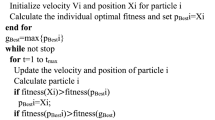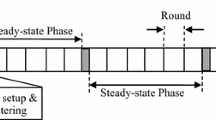Abstract
Sensor networks are traditionally built using battery-powered, collaborative devices. These sensor nodes do not rely on dedicated infrastructure services (e.g., routers) to relay data. Rather, a communal effort is employed where the sensor nodes both generate data as well as forward data for other nodes. A routing protocol is needed in order for the sensors to determine viable paths through the network, but routing protocols designed for wired networks and even ad hoc networks are not sufficient given the energy overhead needed to operate them. We propose an energy-aware routing protocol, based on overlapping swarms of particles, that offers reliable path selection while reducing the energy consumption for the route selection process. Our particle-based routing with overlapping swarms for energy-efficiency algorithm shows promise in extending the life of battery-powered networks while still providing robust routing functionality to maintain network reliability.












Similar content being viewed by others
References
Akkaya, K., & Younis, M. (2005). A survey on routing protocols for wireless sensor networks. Ad Hoc Networks, 3(3), 325–349.
Al-Karaki, J. N., & Kamal, A. E. (2004). Routing techniques in wireless sensor networks: A survey. IEEE Wireless Communications, 11(6), 6–28.
Beyens, P., Peeters, M., Steenhaut, K., & Nowe, A. (2005). Routing with compression in wireless sensor networks: A q-learning approach. In Proceedings of the fifth symposium on adaptive agents and multi-agent systems. AAMAS: Paris, France.
Blum, B., He, T., Son, S., & Stankovic, J. (2003). Igf: A state-free robust communications protocol for wireless sensor networks. Tech. report, University of Virginia.
Brits, R., Engelbrecht, A. P., & van den Bergh, F. (2007). Locating multiple optima using particle swarm optimization. Applied Mathematics and Computation, 189, 1859–1883.
Brown, T. X. (2000). Low power wireless communication via reinforcement learning. Advances in Neural Information Processing Systems (NIPS), 12, 893–899.
Di Caro, G., & Dorigo, M. (1998). Antnet: Distributed stigmergetic control for communications networks. Journal of Artificial Intelligence Research, 9, 316–365.
Di Caro, G., Ducatelle, F., & Gambardella, L. M. (2005). Swarm intelligence for routing in mobile ad hoc networks. Proceedings of the 2005 IEEE Swarm Intelligence Symposium, SIS 2005, pp. 76–83.
Dorigo, M., & Stützle, T. (2004). Ant colony optimization. Cambridge: The MIT Press.
GhasemAghaei, R., Rahman, A., Gueaieb, W., & El Saddik, A. (2007). Ant colony-based reinforcement learning algorithm for routing in wireless sensor networks. Proceedings of the 2007 IEEE instrumentation and measurement technology conference, IMTC 2007, pp. 1–6, May 2007.
Heissenbüttel, M., Braun, T., Bernoulli, T., & Wälchli, M. (2004). Blr: Beacon-less routing algorithm for mobile ad hoc networks. Computer Communications, 27(11), 1076–1086.
Intanagonwiwat, C., Govindan, R., Estrin, D., Heidemann, J., & Silva, F. (2003). Directed diffusion for wireless sensor networking. IEEE/ACM Transactions on Networking, 11(1), 2–16.
Kennedy, J., & Eberhart, R. (1995). Particle swarm optimization. Proceedings of the IEEE International Conference on Neural Networks, 4, 1942–1948.
Littman, M., & Boyan, J. (1993). A distributed reinforcement learning scheme for network routing. In Proceedings of the international workshop on applications of neural networks to telecommunications (pp. 45–51). Hillsdale, NJ.: Lawrence Erlbaum Associates.
Melo, A., & Coello, J. M. A. (2000). Packet scheduling based on learning in the next generation internet architectures. Fifth IEEE symposium on computers and communications, ISCC 2000, 00:773.
Nie, N., & Comaniciu, C. (2006). Energy efficient aodv routing in cdma ad hoc networks using beamforming. EURASIP Journal on Wireless Communications and Networking, 2, 14–14.
Pappa, K., Athanasopoulos, A., Topalis, E., & Koubias, S. (2007). Implementation of power aware features in aodv for ad hoc sensor networks. A simulation study. IEEE conference on emerging technologies and factory automation, ETFA, pp. 1372–1375, Sept. 2007.
Perkins, C. E., & Royer, E. M. (1999). Ad-hoc on-demand distance vector routing. Proceedings of the second IEEE workshop on mobile computing systems and applications, WMCSA ’99, pp. 90–100.
Peshkin, L., & Savova, V. (2002). Reinforcement learning for adaptive routing. Proceedings of the International Joint Conference on Neural Networks, IJCNN ’02, 2, 1825–1830
Shah, R. C., & Rabaey, J. M. (2002). Energy aware routing for low energy ad hoc sensor networks. 2002 IEEE Wireless Communications and Networking Conference, WCNC ’02, 1, 350–355 vol.1.
Tumer, K., & Wolpert, D. (2000). Collective intelligence and braess’ paradox. In Proceedings of the AAAI conference on innovative applications of artificial intelligence, pp. 104–109.
USC/ISI. (2007). The network simulator ns-2. URL http://www.isi.edu/nsnam/ns/.
Wang, P., & Wang, T. (2006). Adaptive routing for sensor networks using reinforcement learning. Sixth IEEE international conference on computer and information technology, CIT’06, 0:219.
Wang, X., Wang, S., & Ma, J. -J. (2007). An improved co-evolutionary particle swarm optimization for wireless sensor networks with dynamic deployment. Sensors, 7(3), 354–370.
Watkins, C. (1989). Learning from delayed rewards. Ph. D thesis, Cambridge: King’s College.
Xue, Y., Lee, H. S., Yang, M., Kumarawadu, P., Ghenniwa, H. H., & Shen, W. (2007). Performance evaluation of ns-2 simulator for wireless sensor networks. 2007 Canadian conference on electrical and computer engineering, CCECE 2007, pp. 1372–1375.
Zhang, H., & Shen, H. (2010). Energy-efficient beaconless geographic routing in wireless sensor networks. IEEE transactions on parallel and distributed systems, 21, 881–896. ISSN 1045-9219. doi:http://doi.ieeecomputersociety.org/10.1109/TPDS.2009.98.
Zhang, X. & Xu, W. (2006). QoS based routing in wireless sensor network with particle swarm optimization, Vol. 4088/2006 (pp. 602–607). Berlin/Heidelberg: Springer.
Acknowledgment
We would like to thank Steve Butcher, Ben Mitchell, Ian Nowland, Chuck Robertson, Pat Donnelly, Omar Zaidan, and the anonymous reviewers for their feedback and suggestions that greatly improved the initial version of this work.
Author information
Authors and Affiliations
Corresponding author
Rights and permissions
About this article
Cite this article
Haberman, B.K., Sheppard, J.W. Overlapping particle swarms for energy-efficient routing in sensor networks. Wireless Netw 18, 351–363 (2012). https://doi.org/10.1007/s11276-011-0404-1
Published:
Issue Date:
DOI: https://doi.org/10.1007/s11276-011-0404-1




